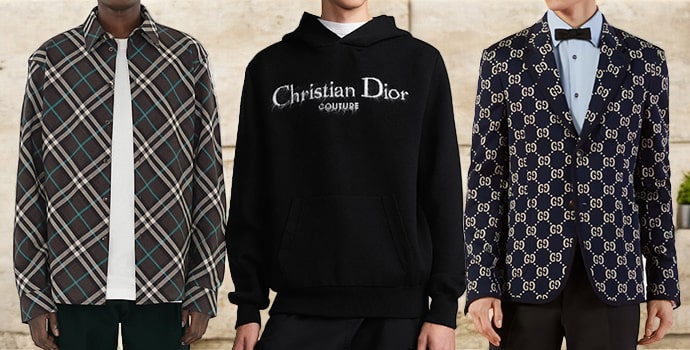How Fabric Choices in Branded Clothing Affect Comfort and Style
How Fabric Choices in Branded Clothing Affect Comfort and Style
Blog Article
Comprehending Garments: The Importance of Fabric Options in Your Wardrobe
The selection of material in apparel plays a critical duty in both looks and functionality. Various products provide varying levels of comfort, sturdiness, and breathability, directly affecting the user's experience. Understanding these subtleties can boost one's wardrobe substantially. Lots of overlook exactly how these choices can affect not simply personal design, however also sustainability. What textile decisions could redefine your wardrobe and align it with both style and responsibility?
The Duty of Material in vogue and Functionality

Common Textile Types and Their Attributes
When picking apparel, recognizing the qualities of common textile kinds is essential for making informed selections. Cotton, a widely-used all-natural fiber, is recognized for its adaptability, breathability, and softness, making it ideal for sportswear and daily garments. Linen, another natural choice, flaunts exceptional moisture-wicking residential properties and a distinctive structure, perfect for cozy climates.Wool, frequently preferred for its heat and sturdiness, differs in fineness; merino woollen is soft versus the skin, while coarser kinds are made use of for outerwear. Artificial materials like polyester and nylon supply resilience and resistance to wrinkles, making them preferred for activewear and traveling garments. Lastly, blends, which integrate synthetic and all-natural fibers, can boost performance while preserving comfort. By acknowledging these textile features, individuals can choose apparel that aligns with their lifestyle and visual choices.
Breathability and Convenience: Selecting the Right Fabrics for Different Environments
Picking the best fabrics for various climates can significantly boost comfort and total wearability. Breathable materials are crucial in warm climates, as they enable air blood circulation and dampness dissipation. Fabrics such as cotton, linen, and moisture-wicking synthetics efficiently attract sweat far from the body, keeping the user cool and completely dry. Alternatively, in colder climates, thicker textiles like wool or fleece give insulation while keeping breathability, making certain heat without overheating.Additionally, the choice of material weight plays a vital duty; lightweight textiles are better for summer, whereas much heavier choices are fit for winter season wear. Understanding the unique buildings of each material enables individuals to clothe suitably for varying weather. Inevitably, selecting breathable and comfortable materials tailored to certain climates can greatly enhance daily comfort and improve the general experience of wearing clothing.
Toughness and Treatment: Just How Textile Influences Durability of Your Wardrobe
Selecting the best materials can greatly impact the durability and treatment needs of a wardrobe. Fabrics such as cotton and polyester are known for their resilience and convenience of maintenance, making them perfect for day-to-day wear. In comparison, fragile products like silk and lace call for more mindful handling and specialized cleansing approaches, which can boost the moment and effort needed for care. Branded Clothing.Durability is additionally affected by the material's weave and finish; firmly woven materials tend to stand up to damage better than freely woven choices. Furthermore, synthetic blends commonly offer enhanced longevity, combining the ideal high qualities of multiple fibers.Understanding the care directions for every fabric is crucial, as improper drying out or cleaning can lead to early wear. Eventually, selecting long lasting products can result in a longer-lasting closet, decreasing the frequency of substitutes and adding to a much more lasting fashion choice
The Impact of Textile on Fit and Silhouette

Lasting Textile Options: Making Eco-Friendly Choices
The effect of textile prolongs beyond fit and shape to encompass environmental aspects, prompting a growing rate of interest in sustainable fabric options. Environmentally friendly fabrics, such as natural cotton, hemp, and Tencel, are getting traction among consumers that prioritize sustainability in their wardrobes. These products are commonly produced with fewer chemicals and water, decreasing their ecological footprint.Additionally, recycled textiles, made from post-consumer waste, supply an innovative service to the textile sector's pollution issue. Brands significantly welcome transparency in their sourcing approaches, permitting consumers to make educated choices concerning their purchases.Choosing lasting materials not just supports ethical practices but also encourages the style industry to embrace more accountable manufacturing methods. As recognition of ecological issues rises, individuals are prompted to assess the long-term effect of their textile choices, fostering a movement in the direction of a much more lasting and ecologically conscious method to style.
Boosting Style: How Fabric Can Transform an Attire
While many you can check here may focus on shade and cut when selecting a clothing, the option of textile plays an essential function in raising style and boosting general look. Various materials share unique state of minds and messages; for instance, silk radiates luxury and elegance, while jeans provides a casual, unwinded ambiance. The texture and drape of a material can significantly alter the shape, with structured materials supplying a polished look and softer ones creating a more fluid, loosened up aesthetic.Moreover, the weight of the textile influences wearability across seasons. Lightweight fabrics like linen and cotton are optimal for summer season, while much heavier materials such as woollen and velvet give heat and style in cooler months. Recognizing material residential properties, such as breathability and stretch, also equips individuals to make educated selections that enhance comfort without compromising style. Inevitably, the appropriate fabric can transform an outfit from regular to amazing, making it a crucial factor to consider in any kind of wardrobe.
Regularly Asked Questions
Just how Do I Identify the Fabric Web Content of My Clothes?
To identify material web content, one can analyze care tags, conduct burn tests for fiber identification, or get in touch with textile examples. These techniques aid set apart materials, guaranteeing informed choices for apparel treatment and upkeep in daily wear.
Can Textile Selection Affect My State Of Mind or Confidence?
Fabric choice can significantly influence a person's state of mind and self-confidence. Branded Clothing. Certain materials may stimulate feelings of comfort or elegance, while others can try this website really feel limiting or uncomplimentary, ultimately affecting self-perception and psychological well-being throughout the day
What Fabrics Are Finest for Delicate Skin?
For people with sensitive skin, natural fabrics like bamboo, linen, and cotton are typically recommended. These products are breathable, hypoallergenic, and much less likely to cause irritability, making them appropriate selections for comfort and skin health and wellness.
Exactly how Do I Correctly Wash and Care for Various Fabrics?
To effectively care and clean for various materials, one must think about each product's details requirements, including temperature settings, detergents, and drying methods, ensuring longevity and keeping the fabric's original top qualities for optimal use.
Exist Details Fabrics for Athletic or Performance Wear?
Athletic or performance wear commonly utilizes textiles such as polyester, spandex, and nylon. These products are developed for moisture-wicking, breathability, and flexibility, boosting motion and convenience during exercises while giving sturdiness and support. On the other hand, in cooler environments, thicker fabrics like wool or fleece offer insulation while preserving breathability, making sure warmth without overheating.Additionally, the option of material weight plays a vital duty; lightweight materials are more suitable for summer season, whereas much heavier options are matched for winter wear. In comparison, fragile products like silk and lace require even more careful handling and specialized cleansing approaches, which can raise the time and initiative required for care.Durability is additionally affected by the material's weave and coating; snugly woven textiles have a tendency to resist wear and tear better than freely woven choices. In contrast, rigid materials can limit activity yet give a timeless, refined look.Moreover, the thickness and appearance of the fabric can affect the visual assumption of body form. The impact of material extends past fit and shape to incorporate environmental aspects, prompting a growing passion in sustainable fabric choices. The structure and drape of a fabric can dramatically alter the shape, with structured textiles offering a polished look and softer ones developing an extra fluid, unwinded aesthetic.Moreover, the weight of the material affects wearability throughout seasons.
Report this page